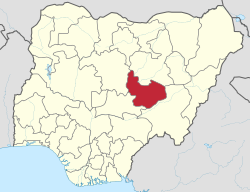INTRODUCTION
Plateau State is one of the six states that make up the North-Central geopolitical zone of Nigeria along with the Federal Capital Territory. It shares borders with Bauchi State to the Northeast, Kaduna State to the Northwest, Nasarawa State to the Southwest and Taraba State to the Southeast, and encloses the Jos Plateau (after which it is named) within its boundaries. The state capital is Jos.
LANDMASS, LOCATION AND POPULATION
Plateau State covers an area of 30,914 square kilometres. It has an estimated population of 3,206,531 (2006 census) 4,200,442 (2016 forecast). The state accounts for 2.3% of Nigeria's population. It is located at latitude 80°24′ North and longitude 80°32′ East.
HISTORY AND PEOPLE
The present day Plateau State was originally part of the Kwararafa Kingdom, one of the seven states of the Hausa Bakwai. Scholars have noted the close linguistic affinity the original settlers of the region, once known as the Kasashen-Bauchi - have with the Jukuns, founders of Kwararafa.
The Kasashen-Bauchi was separated from Kwararafa when the latter kingdom disintegrated around the eighteenth century. Usman dan Fodio brought the kingdom under the Sokoto Caliphate and appointed Yakubu, an indigene of Bauchi to administer it as the first emir. The British colonialists eventually merged Kasashen-Bauchi into Bauchi Province. The Hausas who had settled on the plateau founded the settlement of Jos at the advent of tin mining in the region.
In 1926, Plateau Province (made up of the Jos and Pankshin Divisions) was carved out of Bauchi. It was part of the Northern Region in the three-region structure of 1954. In 1967, Benue and Plateau Provinces were merged to form Benue-Plateau State during the military government of General Yakubu Gowon. At this time, Nigeria had twelve states. Following the creation of nineteen states out of the existing twelve by General Murtala Muhammed military government in 1976, Plateau State was carved out of Benue-Plateau State. In 1996, Nasarawa State was carved out of Plateau State by General Sani Abacha's military government.
The state has over forty ethno-linguistic groups. Some of the indigenous tribes in the state are the Berom, Amo, Anaguta, Gashish, Kofyar (comprising Doemak, Kwalla, and Mernyang), Miango, Talet and Fulani-Kanuri in Wase. Christianity is the main religion in Plateau State, although a significant number of its inhabitants are Muslims.
MAIN TOWNS AND CITIES
Jos (capital), Bukuru, Barkin Ladi, Pankshin, Shendam, Langtang and Vom
LOCAL GOVERNMENT AREAS
ADMINISTRATORS AND GOVERNORS
Dan Suleiman (Governor - Military): March 1976 - July 1978
Joshua Anaja (Governor - Military): July 1978 - October 1979
Solomon Lar (Governor - Civilian (Nigerian People's Party)): October 1979 - December 1983
Samuel Atukum (Governor - Military): January 1984 - August 1985
Chris Alli (Governor - Military): August 1985 - August 1986
Lawrence Onoja (Governor - Military): August 1986 - July 1988
Aliyu Kama (Governor - Military): July 1988 - August 1990
Joshua Madaki (Governor – Military): August 1990 - January 1992
Fidelis Tapgun (Governor - Civilian (Social Democratic Party)): January 1992 - November 1993
Mohammed Mana (Administrator - (Military)): December 1993 - August 1996
Habibu Shuaibu (Administrator - Military): August 1996 - August 1998
Musa Shehu (Administrator - Military): August 1998 - May 1999
Joshua Dariye (Governor - Civilian (People's Democratic Party)): May 1999 - May 2004
Chris Alli (Interim Governor - Civilian (People's Democratic Party)): May 2004 - November 2004
Joshua Dariye (Governor - Civilian (People's Democratic Party)): November 2004 - November 2006
Michael Botmang (Governor - Civilian (People's Democratic Party)): November 2006 - April 2007
Joshua Dariye (Governor - Civilian (People's Democratic Party)): April 2007 - May 2007
Jonah Jang (Governor - Civilian (People's Democratic Party)): May 2007 - May 2015
Simon Lalong (Governor - Civilian (All Progressives Congress)) May 2015 – Present
ECONOMY AND EDUCATION
Agriculture is the major economic activity in Plateau State. Crops found in the state include tobacco, potato, beans, cotton, shea-nut, cowpeas, sugarcane, onion, pepper and ginger. Cattle, sheep and goats are reared there. The state is home to a number of minerals such as tin, clay, mica, granite, silica, feldspar, gold, gypsum, limestone, phosphate, quartz, kaolin and sand. Plateau State has a number of agro-based, mining and extractive industries.
The tertiary institutions in the state are University of Jos, Plateau State University, Bokkos; Plateau State Polytechnic, Barkin Ladi; Federal College of Animal Health and Production Technology, Vom; Federal College of Education, Pankshin; Federal College of Forestry, Jos; Federal College of Land Resources Technology, Kuru; Plateau State College of Agriculture, Garkawa; and College of Education, Gindiri.
FAMOUS SITES AND CULTURE
Sites
Riyom Rock, Riyom
Riyom Rock in Riyom town, Riyom local government area which comprises of several big stones laid on top of each other is one of the mysterious rock formations in Nigeria. The stones are about a three-storey building.
Wase Rock, Wase
Wase Rock, near Wase town, Wase local government area is a dome-shaped mountain with a massive height of 176 metres. It is the remnant of a giant volcano and covers 321 hectares of land and can be viewed from a distance of about 40 kilometres because of its remarkable height. It is one of the five breeding places for the Rossy white pelican birds in Africa.
Jos National Museum, Jos
Established in 1952, the Jos National Museum is a very important centre for research into the prehistoric culture of Nigeria. It has a huge collection of ancient relics including Nok terracotta collections dating back to 200AD and crafted pottery from across Nigeria.
Culture
The Nzem Berom cultural festival is an important event among the Berom speaking people in the northern part of Plateau State. The festival heralds the planting season and is celebrated between March and April every year. The Tarok people mark the Taroh Cultural Day to promote the community’s cultural heritage.Other major celebrations in the state are the Bel/Sombi Cultural festival, Wushiri Cultural festival and Afrizere Cultural festival.
NOTABLE INDIGENES
Domkat Bali (1940 – 2020)
Joseph Garba (1943 -2002)
DID YOU KNOW
The National Museum in Jos was the first public museum in Nigeria. It was set up by Bernard Fagg, a British historian who also first discovered the Nok terracotta sculptures.
PLATEAU STATE IN PICTURES

